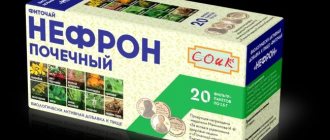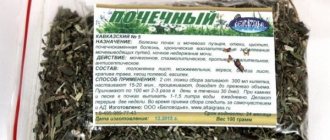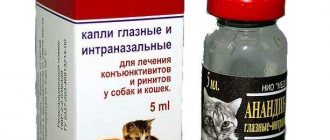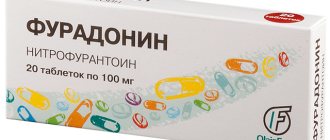Write a review
Reviews: 0
Manufacturers: Ranbaxy Laboratories Ltd
Active ingredients
- Tinidazole
- Ciprofloxacin
Disease class
- Diabetes mellitus, unspecified, with peripheral circulatory disorders
- Chronic sinusitis
- Abscess of the lung and mediastinum
- Pyothorax
- Chronic periodontitis
- Peritonitis
- Local infection of skin and subcutaneous tissue, unspecified
- Decubital ulcer
- Osteomyelitis, unspecified
- Periostitis in other infectious diseases classified elsewhere
- Acute amoebic dysentery
- Diarrhea and gastroenteritis of suspected infectious origin
- Surgical practice
- Inflammatory diseases of the female pelvic organs, unspecified
Clinical and pharmacological group
- Not indicated. See instructions
Pharmacological action
- Broad spectrum antibacterial action
- Bactericidal
Pharmacological group
- Quinolones/fluoroquinolones in combinations
- Other synthetic antibacterial agents in combinations
Oral tablets Cifran CT
Instructions for medical use of the drug
Description of pharmacological action
A combined drug intended for the treatment of mixed infections caused by anaerobic and aerobic microorganisms, as well as gastrointestinal infections, such as diarrhea or dysentery, of amoebic or mixed (amebic and bacterial) nature. Tinidazole is effective against anaerobic microorganisms such as Clostridium difficile, Clostridium perfringens, Bacteroides fragilis, Peptococcus and Peptostreptococcus anaerobius. Anaerobic microorganisms cause mainly diseases of the abdominal cavity, pelvis, lungs or oral organs. In an anaerobic infection, most often there is a mixture of anaerobic and aerobic bacteria. Therefore, in case of mixed anaerobic infection, an antibiotic active against aerobic bacteria is added to therapy. Ciprofloxacin is a broad-spectrum antibiotic, active against most aerobic gram-positive and gram-negative microorganisms, such as E.coli, Klebsiella spp., S.typhi and other strains of Salmonella, P.mirabilis, P.vulgaris, Yersinia enterocoilitica, Ps.aeruginosa, Shigella flexneri, Shigella sonnei, H.ducreyi, H.influenzae, N.gonorrhoeae, M.catarrhalis, V.cholerae, B.fragilis, St.aureus (including methicillin-resistant strains), St.epidermidis, S.pyogenes, S .pneumoniae, Chlamydia, Mycoplasma, Legionella and Mycobacterium tuberculosis.
Indications for use
Treatment of mixed infections caused by sensitive anaerobic and aerobic microorganisms: - chronic sinusitis; - lung abscess; - empyema; - intra-abdominal infections; - inflammatory gynecological diseases; — postoperative infections (with the possible presence of aerobic and anaerobic bacteria); — chronic osteomyelitis; - infections of the skin and soft tissues; - ulcers on diabetic feet; - bedsores; - infections of the oral cavity (including periodontitis and periostitis). Treatment of diarrhea or dysentery of amoebic or mixed (amebic and bacterial) etiology.
Release form
film-coated tablets 500 mg + 600 mg; blister 10 cardboard pack 1; film-coated tablets 500 mg + 600 mg; blister 10 cardboard pack 10; film-coated tablets 250 mg + 300 mg; blister 10 cardboard pack 1; film-coated tablets 250 mg + 300 mg; blister 10 cardboard pack 10; Composition Film-coated tablets (250 mg + 300 mg) 1 tablet. ciprofloxacin hydrochloride USP equivalent to ciprofloxacin 250 mg tinidazole BP 300 mg blister 10 pcs.; There are 1 or 10 blisters in a box. Film-coated tablets (500 mg + 600 mg) 1 tablet. ciprofloxacin hydrochloride USP equivalent to ciprofloxacin 500 mg tinidazole BP 600 mg blister 10 pcs.; There are 1 or 10 blisters in a box.
Pharmacodynamics
A combined drug intended for the treatment of mixed infections caused by anaerobic and aerobic microorganisms, as well as gastrointestinal infections, such as diarrhea or dysentery, of amoebic or mixed (amebic and bacterial) nature. Tinidazole is effective against anaerobic microorganisms such as Clostridium difficile, Clostridium perfringens, Bacteroides fragilis, Peptococcus and Peptostreptococcus anaerobius. Anaerobic microorganisms cause mainly diseases of the abdominal cavity, pelvis, lungs or oral organs. In an anaerobic infection, most often there is a mixture of anaerobic and aerobic bacteria. Therefore, in case of mixed anaerobic infection, an antibiotic active against aerobic bacteria is added to therapy. Ciprofloxacin is a broad-spectrum antibiotic, active against most aerobic gram-positive and gram-negative microorganisms, such as E.coli, Klebsiella spp., S.typhi and other strains of Salmonella, P.mirabilis, P.vulgaris, Yersinia enterocoilitica, Ps.aeruginosa, Shigella flexneri, Shigella sonnei, H.ducreyi, H.influenzae, N.gonorrhoeae, M.catarrhalis, V.cholerae, B.fragilis, St.aureus (including methicillin-resistant strains), St.epidermidis, S.pyogenes, S .pneumoniae, Chlamydia, Mycoplasma, Legionella and Mycobacterium tuberculosis.
Pharmacokinetics
Both ciprofloxacin and tinidazole are well absorbed from the gastrointestinal tract. The Cmax of each component is achieved within 1–2 hours. The complete bioavailability of tinidazole is 100%, and plasma protein binding is 12%. T1/2 - about 12–14 hours. The drug quickly penetrates the body tissues, reaching high concentrations there. Tinidazole creates concentrations in the cerebrospinal fluid equal to its plasma concentrations and is reabsorbed in the renal tubules. Tinidazole is excreted into bile in concentrations slightly below 50% of its plasma concentration. About 25% of the dose taken is excreted unchanged in the urine. Metabolites account for 12% of the administered dose and are also excreted in the urine. Along with this, there is a slight excretion of tinidazole in feces. Ciprofloxacin is well absorbed after oral administration. The bioavailability of ciprofloxacin is about 70%. When used together with food, the absorption of ciprofloxacin is slowed down. 20–40% of the drug is bound to plasma proteins. Ciprofloxacin penetrates well into fluids and tissues of the body: lungs, skin, fat, muscle and cartilage tissue, as well as bone tissue and organs of the urinary system, prostate. The drug is found in high concentrations in saliva, nasal mucus and bronchial secretions, semen, lymph, peritoneal fluid, bile and prostate secretions. Ciprofloxacin is partially metabolized by the liver. About 50% of the dose taken is excreted unchanged in the urine, 15% in the form of active metabolites such as oxyciprofloxacin. The rest of the dose is excreted in bile, partially reabsorbed. About 15–30% of ciprofloxacin is excreted in the feces. T1/2 - about 3.5–4.5 hours. T1/2 can be prolonged with severe renal failure and in elderly patients.
Use during pregnancy
Use during pregnancy is not recommended. Tinidazole may be carcinogenic and mutagenic. Ciprofloxacin penetrates the hematoplacental barrier. Use is contraindicated during breastfeeding. Tinidazole and ciprofloxacin are excreted into breast milk. Therefore, during lactation, if the use of the drug is necessary, breastfeeding should be stopped.
Contraindications for use
- hypersensitivity to any fluoroquinolone or imidazole derivatives; - hematological diseases; - organic neurological lesions; - inhibition of bone marrow hematopoiesis; - porphyria; - children's age (up to 18 years). With caution: severe cerebral atherosclerosis; cerebrovascular accident; mental illness, epilepsy, epileptic syndrome; severe renal and/or liver failure. When using the drug in the elderly, no significant problems were noted. However, in elderly patients, an age-dependent decrease in renal function is possible, so caution should be exercised when using the drug in such patients.
Side effects
From the digestive system: loss of appetite, dryness of the oral mucosa, “metallic” taste in the mouth, nausea, vomiting, diarrhea, abdominal pain, flatulence, cholestatic jaundice (especially in patients with previous liver diseases), hepatitis, hepatonecrosis. From the side of the central nervous system: headache, dizziness, increased fatigue, impaired coordination of movements (including locomotor ataxia), dysarthria, peripheral neuropathy, rarely convulsions, weakness, tremor, insomnia, increased sweating, increased intracranial pressure, confusion, depression , hallucinations, as well as other manifestations of psychotic reactions, migraine, fainting, thrombosis of cerebral arteries. From the senses: disturbances of taste and smell, visual impairment (diplopia, changes in color vision), tinnitus, hearing loss. From the cardiovascular system: tachycardia, heart rhythm disturbances, decreased blood pressure. From the hematopoietic system: leukopenia, granulocytopenia, anemia, thrombocytopenia, leukocytosis, thrombocytosis, hemolytic anemia. Laboratory indicators: hypoprothrombinemia, increased activity of liver transaminases and alkaline phosphatase, hypercreatinemia, hyperbilirubinemia, hyperglycemia. From the urinary system: hematuria, crystalluria (with alkaline urine and low diuresis), glomerulonephritis, dysuria, polyuria, urinary retention, decreased nitrogen excretory function of the kidneys, interstitial nephritis. Allergic reactions: skin itching, urticaria, blistering accompanied by bleeding and the appearance of small nodules that form scabs, drug fever, pinpoint hemorrhages on the skin (petechiae), swelling of the face or larynx, shortness of breath, eosinophilia, increased photosensitivity, vasculitis, erythema nodosum, exudative erythema multiforme (including Stevens-Johnson syndrome), toxic epidermal necrolysis (Lyell's syndrome). Other: arthralgia, arthritis, tenosynovitis, tendon ruptures, asthenia, myalgia, superinfections (candidiasis, pseudomembranous colitis), flushing.
Directions for use and doses
Inside, after meals, with plenty of water. Do not break, chew, or otherwise destroy the tablet. Recommended dose for adults Tsifran® ST 250/300 mg - 2 tablets. 2 times a day. Tsifran® ST 500/600 mg - 1 tablet. 2 times a day.
Overdose
Treatment: therapy for an overdose of the drug Cifran® ST should be symptomatic and include the following measures: - induction of vomiting or gastric lavage, - measures for adequate hydration of the body (infusion therapy); - maintenance therapy. There is no specific antidote.
Interactions with other drugs
Tinidazole Enhances the effect of indirect anticoagulants (to reduce the risk of bleeding, the dose is reduced by 50%) and the effect of ethanol (disulfiram-like reactions). Compatible with sulfonamides and antibiotics (aminoglycosides, erythromycin, rifampicin, cephalosporins). Not recommended for use with ethionamide. Phenobarbital speeds up metabolism. Ciprofloxacin Due to a decrease in the activity of microsomal oxidation processes in hepatocytes, it increases the concentration and lengthens T1/2 of theophylline (and other xanthines, such as caffeine), oral hypoglycemic drugs, indirect anticoagulants, and helps reduce the prothrombin index. When combined with other antimicrobial drugs (beta-lactam antibiotics, aminoglycosides, clindamycin, metronidazole), synergism is usually observed. Strengthens the nephrotoxic effect of cyclosporine, there is an increase in serum creatinine; in such patients it is necessary to monitor this indicator 2 times a week. When taken simultaneously, it enhances the effect of indirect anticoagulants. Oral administration together with iron-containing drugs, sucralfate and antacid drugs containing Mg2+, Ca2+, A13+ leads to a decrease in the absorption of ciprofloxacin, so it should be prescribed 1-2 hours before or 4 hours after taking the above drugs. NSAIDs (excluding acetylsalicylic acid) increase the risk of seizures. Didanosine reduces the absorption of ciprofloxacin due to the formation of complexes with Mg2+ and A13+ contained in didanosine. Metoclopramide accelerates absorption, which leads to a decrease in the time to reach its maximum concentration. Co-administration of uricosuric drugs leads to a slower elimination (up to 50%) and an increase in plasma concentrations of ciprofloxacin.
Special instructions for use
It is recommended to avoid excessive exposure to sunlight during the course of therapy with Cifran® ST, since phototoxicity reactions have been observed in some patients receiving fluoroquinolones. If phototoxicity reactions occur, you should immediately stop using the drug. When using tinidazole, it is possible (but rare) to develop generalized urticaria, swelling of the face and larynx, decreased blood pressure, bronchospasm and dyspnea. If the patient is allergic to any imidazole derivative, cross-sensitivity to tinidazole may also develop; the development of a cross-allergic reaction to ciprofloxacin is also possible in patients with allergies to other fluoroquinolone derivatives. Therefore, if the patient has had any allergic reactions to similar drugs, the possibility of cross-allergic reactions to Cifran® ST should be taken into account. When tinidazole is used together with alcohol, painful abdominal cramps, nausea and vomiting may occur. Therefore, the combined use of Cifran® ST and alcohol is contraindicated. To avoid the development of crystalluria, it is unacceptable to exceed the recommended daily dose; sufficient fluid intake and maintaining an acidic urine reaction are also necessary. Causes dark coloration of urine. During treatment, you should refrain from engaging in potentially hazardous activities that require increased attention and speed of mental and motor reactions. For patients with epilepsy, a history of seizures, vascular diseases and organic brain damage, due to the risk of developing adverse reactions from the central nervous system, the drug should be prescribed only for health reasons. If severe and prolonged diarrhea occurs during or after treatment, the diagnosis of pseudomembranous colitis should be excluded, which requires immediate discontinuation of the drug and the appointment of appropriate treatment. If pain appears in the tendons or when the first signs of tenosynovitis appear, treatment should be stopped. During treatment, peripheral blood patterns should be monitored. The safety and effectiveness of use for the treatment and prevention of anaerobic infections in children under 12 years of age has not been established.
Storage conditions
List B.: In a dry place, at a temperature not exceeding 25 °C.
Best before date
24 months
ATX classification:
J Antimicrobials for systemic use
J01 Antimicrobials for systemic use
Cifran® OD (Cifran OD)
A broad-spectrum antimicrobial drug from the group of fluoroquinolones. Acts bactericidal. The drug inhibits the enzyme DNA gyrase of bacteria, as a result of which the replication and synthesis of bacterial cellular proteins are disrupted. Ciprofloxacin acts on gram-negative microorganisms during the period of rest and division (since it affects not only DNA gyrase, but also causes lysis of the cell wall), on gram-positive microorganisms - only during the period of division. Low toxicity for the cells of the macroorganism is explained by the absence of DNA gyrase in them. While taking ciprofloxacin, there is no parallel development of resistance to other antibacterial drugs. does not belong to the group of gyrase inhibitors, which makes it highly effective against bacteria that are resistant, for example, to aminoglycosides and penicillins. cephalosporins, tetracyclines and many other antibacterial drugs.
Resistance to ciprofloxacin develops slowly and gradually. When using ciprofloxacin, there were no cases of plasmid resistance, which often develops with the use of beta-lactam antibiotics, aminoglycosides and tetracyclines. Bacteria containing plasmids are also highly sensitive to ciprofloxacin.
During the use of ciprofloxacin, parallel resistance of pathogens to antibiotics of other groups does not develop: β-lactam antibiotics, aminoglycosides. tetracyclines, macrolides, sulfonamides, derivatives of trimethoprim or nitrofuran. Therefore, ciprofloxacin is highly effective against bacteria resistant to antibiotics of these groups.
Ciprofloxacin remains effective against pathogens resistant to other gyrase inhibitors.
Due to its chemical structure, ciprofloxacin is highly effective against strains that produce β-lactamases.
In vitro susceptibility testing by
the European Committee on Antimicrobial Susceptibility Testing (EUCAST), are presented in the table below:
European Committee on Antibiotic Susceptibility Testing. Clinical minimum inhibitory concentration (MIC) breakpoints (mg/mL) for ciprofloxacin.
| Microorganism | Sensitive (mg/l) | Resistant (mg/l) |
| Enterobacteriaceae | ≤0,5 | >1 |
| Pseudomonas spp. | ≤0,5 | >1 |
| Acinetobacter spp. | ≤1 | >1 |
| Staphylococcus 1 ssp. | ≤1 | >1 |
| Streptococcus pneumoniae2 | <0,125 | >2 |
| Haemophilus influenzae and Moraxella catarrhalis3 | ≤0,5 | >0,5 |
| Neisseria gonorrhoeae | ≤0,03 | >0,06 |
| Neisseria meningitides | ≤0,03 | >0,06 |
| Boundary values not related to microorganism species4 | ≤0,5 | >1 |
1. Staphylococcus spp. — breakpoints for ciprofloxacin and ofloxacin are associated with high-dose therapy.
2. Streptococcus pneumoniae - wild type S. pneumoniae is not considered susceptible to ciprofloxacin and ofloxacin and is thus classified as intermediately susceptible.
3. Strains with MIC values exceeding the sensitive/moderately sensitive threshold ratio are very rare and have not been reported to date. Identification and antimicrobial susceptibility tests should be repeated when such colonies are detected, and the results should be confirmed by colony testing at a reference laboratory. Until evidence of clinical response is available for strains with confirmed MIC values above the currently used resistance threshold, they should be considered resistant. Haemophilus spp./Moraxella spp. - it is possible to identify strains of Haemophilus influenzae with low sensitivity to fluoroquinolones (MIC for ciprofloxacin - 0.125-0.5 mg/l). There is no evidence of the clinical significance of low resistance in respiratory tract infections caused by H. infuenzae.
4. Non-species-specific breakpoints were determined primarily on the basis of pharmacokinetics/pharmacodynamics data and are independent of species-specific MIC distributions. They are only applicable to species for which a species-specific susceptibility threshold has not been determined, and not to those species for which susceptibility testing is not recommended. For certain strains, the distribution of acquired resistance may vary across geographic regions and over time. Therefore, it is desirable to have local information on resistance, especially when treating local infections.
Clinical and Laboratory Standards Institute data for MIC breakpoints (mg/mL) and diffusion testing using 5 μg ciprofloxacin discs.
Clinical and Laboratory Standards Institute. Breakpoints for MIC (mg/L) and diffusion testing (mm) using disks.
| Microorganism | Sensitive | Intermediate | Resistant | ||||
| Enterobacteriaceae | <1a | 2a | >4a | ||||
| ≥21 b | 16-20b | <15a | |||||
| Pseudomonas aeruginosa and other bacteria belonging to the family Enterobacteriaceae | a | 2a | >4a | ||||
| >21b | 16-20 b | <15 b | |||||
| Staphylococcus spp. | a | 2a | >4a | ||||
| >21 b | 16-20 b | <15 b | |||||
| Enterococcus spp. | a | 2a | >4a | ||||
| >21 b | 16-20 b | <15 b | |||||
| Haemophilus spp. | <1v | — | — | ||||
| >21y | — | — | |||||
| Neisseria gonorrhoeae | <0.06d | 0.12-0.5D | >1d | ||||
| >41d | 28-40d | <27d | |||||
| Neisseria meningitides | <0.03e | 0.06e | >1.12e | ||||
| >35f | 33-34f | <32f | |||||
| Bacillus anthracis Yersinia pestis | <0.25a | ||||||
| Francisella tularensis | <0.5a | ||||||
A.
This reproducible standard is only applicable to broth dilution tests using cationically adjusted Mueller-Hinton broth (CAMHB) incubated with air at 35±2°C for 16-20 hours for strains of Enterobacteriaceae, Pseudomonas aeruginosa, etc. bacteria not belonging to the Enterobacteriaceae family, Staphylococcus spp., Enterococcus spp., and Bacillus anthracis: 20-24 hours for Acinetobacter spp., 24 hours for Y. pestis (if growth is insufficient, incubate for another 24 hours).
b.
This reproducible standard is only applicable to disc diffusion tests using air at 35±2°C for 16-18 hours.
V.
This reproducible standard is only applicable to susceptibility disk diffusion tests with Heamophilus influenzae and Heamophilus parainfluenzae using broth test medium for Heamophilus spp. (NTM), which is inhibited with access to air at a temperature of 35±2°C for 20-24 hours.
G.
This reproducible standard is only applicable to disc diffusion tests using NTM incubated in 5% CO2 at 35±2°C for 16-18 hours.
d.
This reproducible standard is only applicable to susceptibility tests (zone disc diffusion tests and MIC agar solution) using gonococcal agar and 1% specified growth supplement at 36±2°C (not to exceed 37°C) in 5% CO2 within 20-24 hours.
e.
This reproducible standard is only applicable to broth dilution tests using cationically adjusted Mueller-Hinton broth (CAMHB) supplemented with 5% sheep blood, which is incubated in 5% CO2 at 35±2°C for 20-24 hours.
and.
This reproducible standard is applicable only to broth dilution tests using cationically adjusted Mueller-Hinton broth (CAMHB) supplemented with a specified 2% growth additive, which is incubated with air at 35 ± 2°C for 48 hours.
In - Vitro
susceptibility to ciprofloxacin
For certain strains, the distribution of acquired resistance may vary depending on the geographic region and over time. Therefore, it is desirable to have local information on resistance when testing strain susceptibility, especially when treating severe infections. If the local prevalence of resistance is such that the benefit of the drug, at least against several types of infections, is questionable, it is necessary to consult a specialist.
In-vitro activity of ciprofloxacin has been demonstrated against the following sensitive strains of microorganisms:
Aerobic gram-positive microorganisms:
Bacillus
anthracis , Staphylococcus aureus (methicillin-sensitive), Staphylococcus saprophyticus , Streptococcus spp .
Aerobic gram-negative microorganisms:
Aeromonas
spp ., Moraxella catarrhalis , Brucella spp ., Neisseria meningitidis , Citrobacter koseri , Pasteurella spp ., Francisella tularensi , Salmonella spp ., Haemophilus ducreyi , Shigella spp ., Haemophilius influenzae , Vibrio spp ., Legionella spp ., Yersinia pestis .
Anaerobic microorganisms:
Mobiluncus
spp .
Other microorganisms:
Chlamydia trachomatis, Chlamydia pneumoniae, Mycoplasma hominis, Mycoplasma pneumoniae.
Varying degrees of sensitivity to ciprofloxacin have been demonstrated for the following microorganisms:
Acinetobacter baumann, Burkholderia cepacia, Campylobacter spp., Citrobacter freundii, Enterococcus faecal is, Enterobacter aerogenes, Enterobacter cloacae, Escherichia coli, Klebsiella pneumoniae, Klebsiella oxytoca, Morganella morganii, Neisseria gonorrhoeae, Proteus mirabilis, Proteus vulgaris, Providencia spp., Pseudomonas aeruginosa, Pseudomonas fluorescens, Serratia marcescens, Streptococcus pneumoniae, Peptostreptococcus spp., Propionibacterium acnes.
Staphylococcus aureus is believed to be naturally resistant to ciprofloxacin.
(methicillin-resistant),
Stenotrophomonas maltophilia, Actinomyces spp., Enterococcus faecium, Listeria monocytogenes, Mycoplasma genitalium, Ureaplasma urealitycum,
anaerobic microorganisms (except
Mobiluncus spp., Peptostreptococcus spp., Propionibacterium acnes).
Similar drugs:
- Augmentin Oral tablets
- Tea tree DN Ointment for external use
- Augmentin Powder for suspension for oral administration
- Bactrim Oral suspension
- Dioxydin Mouth rinse solution
- Pancef Oral tablets
- Nifuroxazide (Nifuroxazide) Oral tablets
- Cifran OD Oral tablets
- Pancef Granules for the preparation of suspension for oral administration
- Augmentin ES Powder for oral solution
** The Drug Directory is intended for informational purposes only. For more complete information, please refer to the manufacturer's instructions. Do not self-medicate; Before starting to use the drug Cifran ST, you should consult a doctor. EUROLAB is not responsible for the consequences caused by the use of information posted on the portal. Any information on the site does not replace medical advice and cannot serve as a guarantee of the positive effect of the drug.
Are you interested in the drug Cifran ST? Do you want to know more detailed information or do you need a doctor's examination? Or do you need an inspection? You can make an appointment with a doctor - the Euro lab is always at your service! The best doctors will examine you, advise you, provide the necessary assistance and make a diagnosis. You can also call a doctor at home . Euro lab clinic is open for you around the clock.
** Attention! The information presented in this medication guide is intended for medical professionals and should not be used as a basis for self-medication. The description of the drug Cifran ST is provided for informational purposes and is not intended for prescribing treatment without the participation of a doctor. Patients need to consult a specialist!
If you are interested in any other drugs and medications, their descriptions and instructions for use, information about the composition and form of release, indications for use and side effects, methods of use, prices and reviews of drugs, or you have any other questions and suggestions - write to us, we will definitely try to help you.





